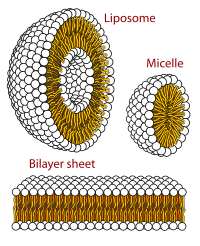
Photo from wikipedia
L form bacteria do not have a cell wall and are thought to require medium of high osmolality for survival and growth. In this study we tested whether L forms… Click to show full abstract
L form bacteria do not have a cell wall and are thought to require medium of high osmolality for survival and growth. In this study we tested whether L forms can adapt to growth in lower osmolality medium. We first tested the Escherichia coli L form NC-7, generated in 1987 by Onoda following heavy mutagenesis. We started with growth in osmoprotective medium (~ 764 mOsm kg-1) and diluted it stepwise into medium of lower osmolality. At each step the cells were given up to 10 days to adapt and begin growing, during which they apparently acquired multiple new mutations. We eventually obtained a strain that could grow in LB containing only 34 mM NaCl, 137 mOsm kg-1 total. NC-7 showed a variety of morphologies including spherical, angular and cylindrical cells. Some cells extruded a bud that appeared to be the outer membrane enclosing an enlarged periplasm. Additional evidence for an outer membrane was sensitivity of the cells to the compound CHIR-090, which blocks the LPS pathway, and to EDTA which chelates Mg that may stabilize and rigidify the LPS in the outer membrane. We suggest that the mechanical rigidity of the outer membrane enables the angular shapes and provides some resistance to turgor in the low-osmolality media. Interestingly, cells that had an elongated shape underwent division shortly after addition of EDTA, suggesting that reducing the rigidity of the outer membrane under some turgor pressure induces division before lysis occurs. We then tested a well-characterized L form from Bacillus subtilis. L form strain LR-2L grew well with sucrose at 1246 and 791 mOsm kg-1. It survived when diluted directly into 440 mOsm kg-1 but grew poorly, achieving only 1/10 to 1/5 the density. The B. subtilis L form apparently adapted to this direct dilution by rapidly reducing cytoplasmic osmolality.
Journal Title: Microbiology
Year Published: 2019
Link to full text (if available)
Share on Social Media: Sign Up to like & get
recommendations!